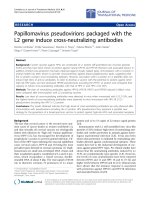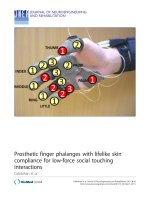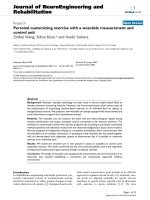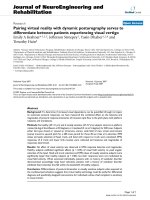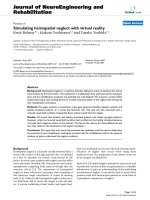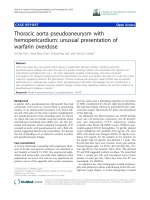Báo cáo hóa học: "SECOND-ORDER DIFFERENTIAL EQUATIONS WITH DEVIATING ARGUMENTS" pptx
Bạn đang xem bản rút gọn của tài liệu. Xem và tải ngay bản đầy đủ của tài liệu tại đây (683.31 KB, 15 trang )
SECOND-ORDER DIFFERENTIAL EQUATIONS WITH
DEVIATING ARGUMENTS
T. JANKOWSKI AND W. SZATANIK
Received 2 May 2006; Revised 22 May 2006; Accepted 28 May 2006
This paper deals with boundary value problems for second-order differential equations
with deviating arguments. Some sufficient conditions are formulated under which such
problems have quasisolutions or a unique solution. A monotone iterative method is used.
Examples with numerical results are added to illustrate the results obtained.
Copyright © 2006 T. Jankowski and W. Szatanik. This is an open access article distributed
under the Creative Commons Attribution License, which permits unrestricted use, dis-
tribution, and reproduction in any medium, provided the original work is properly cited.
1. Introduction
Let us consider a problem
x
(t) = f
t,x(t),x
α(t)
≡
Fx(t), t ∈ J = [0,T], T<∞,
x(0)
= 0, x(T) =rx(γ)withγ ∈ (0,T),
(1.1)
where f
∈ C(J ×R ×R,R)andα ∈ C(J,J)(e.g.,α may be defined by α(t) =
√
t, T ≥1or
α(t)
= 0.7t, t ∈ J). Moreover, r and γ are fixed real numbers.
Differential equations with deviated arguments arise in a variety of areas of biologi-
cal, physical, and engineering applications, see, for example, [9, Chapter 2]. The mono-
tone iterative method is useful to obtain approximate solutions of nonlinear differential
equations, for details see, for example, [10], see also [1–8, 11, 12]. It has been applied
successfully to obtain results of existence of quasisolutions for problems of type (1.1), see
[4]. In paper [4], it was assumed that function f satisfies a one-sided Lipschitz condition
with respect to the last two variables with corresponding functions instead of constants.
Note that the special case when f is monotone nonincreasing (with respect to the last two
variables) is not discussed in paper [4] and is of particular interest. Moreover, at the end
of this paper we formulate conditions under w hich problem (1.1) has a unique solution.
This paper extends some results of [4].
Hindawi Publishing Corporation
Boundary Value Problems
Volume 2006, Article ID 23092, Pages 1–15
DOI 10.1155/BVP/2006/23092
2 Second-order differential equations
The plan of this paper is as follows. In Section 3, we discuss problem (1.1)forthecase
when r
≤ 0. Theorem 3.1 says about extremal quasisolutions of problem (1.1). Example
3.2 illustrates that assumptions of Theorem 3.1 are satisfied, so the problem (3.13), from
this example, has extremal quasisolutions which are the limit of sequences
{y
n
,z
n
}.To
obtain an approximate extremal quasisolutions we can use the elements of sequences
{y
n
,z
n
}. Using numerical methods we can find numerical approximations y
n
, z
n
of y
n
, z
n
,
respectively. The graphs of some
y
n
, z
n
are given in Figure 3.1.InSection 4,weinvestigate
problems having more deviating arguments. Also an example and graphs of numerical
approximations of
y
n
, z
n
are given. In Section 6, we combined results of this paper with
corresponding results of [4]. Example 6.5 shows the results obtained. In the last section,
we investigate the problem when the minimal and maximal quasisolutions are equal, so
when our problem has a unique solution.
2. Lemmas and definitions
We need some lemmas which are useful in this paper.
It is easy to show the following.
Lemma 2.1. Let p
∈ C
2
(J,R) and
p
(t) ≥ 0 for t ∈ J,
p(0)
≤ 0, p(T) ≤0.
(2.1)
Then p(t)
≤ 0 on J.
It is a well-known fact which follows from Green function properties that the following
holds.
Lemma 2.2. Let
G(t,s)
=−
1
T
⎧
⎪
⎨
⎪
⎩
(T −t)s for 0 ≤s ≤t ≤ T,
(T
−s)t for 0 ≤t ≤ s ≤T.
(2.2)
Let h : J
→ R be integrable on J. Then the problem
u
(t) = h(t), u(0) = 0, u(T) = β (2.3)
has exactly one solution given by
u(t)
=
T
0
G(t,s)h(s)ds+
β
T
t. (2.4)
We assume in all definitions below that r
≤ 0.
T. Jankowski and W. Szatanik 3
Definit ion 2.3. A pair of functions y
0
,z
0
∈ C
2
(J,R)iscalledcoupled lower and upper
solutions of (1.1)if
y
0
(t) ≥ Fz
0
(t), y
0
(0) ≤ 0, y
0
(T) ≤ rz
0
(γ),
z
0
(t) ≤ Fy
0
(t), z
0
(0) ≥ 0, z
0
(T) ≥ ry
0
(γ),
(2.5)
where t
∈ J.
Definit ion 2.4. A pair of functions Y,Z
∈ C
2
(J,R)iscalledcoupled quasisolutions of (1.1)
if
Y
(t) = FZ(t), Y(0) = 0, Y(T) =rZ(γ),
Z
(t) = FY(t), Z(0) =0, Z(T) = rY(γ),
(2.6)
where t
∈ J.
Let f ,g
∈ C
2
(J,R)and f (t) ≤ g(t)fort ∈ J. We will say that a function e ∈ C
2
(J,R)
belongs to segment [ f ,g]if f (t)
≤ e(t) ≤ g(t)fort ∈ J.
Definit ion 2.5. Let a pair (U, V) be a coupled quasisolutions of (1.1). (U,V )arecalled
minimal and maximal coupled quasisolutions of (1.1)ifforanyelse
U, V coupled qua-
sisolutions of (1.1), it holds that U(t)
≤ U(t), V(t) ≤V(t), t ∈ J.
Let u, v
∈ C
2
(J,R) satisfy u(t) ≤ v(t)fort ∈ J. Coupled quasisolutions U, V of (1.1)
are called minimal and maximal coupled quasisolutions in segment [u,v]ifu(t)
≤ U(t),
V(t)
≤ v(t)fort ∈J and for any else (Y, Z) coupled quasisolutions of (1.1), such as u(t) ≤
Y(t), Z(t) ≤ v(t)fort ∈ J, it holds that U(t) ≤Y(t)andZ(t) ≤V(t), t ∈ J.
Remark 2.6. Note that if a function y is a solution of (1.1), then the pair (y, y)willbe
coupled quasisolutions of (1.1).
3. Main results if r
≤ 0
Now we formulate conditions which guarantee that problem (1.1) has extremal quasiso-
lutions.
Theorem 3.1. Let r
≤ 0, f ∈ C(J ×R ×R,R),andα ∈ C(J,J).Lety
0
, z
0
be coupled lower
and upper solutions of (1.1)andy
0
(t) ≤ z
0
(t), t ∈J. Moreover, assume that
f
t,u
1
,v
1
−
f
t,u
1
,v
1
≤
0 (3.1)
for y
0
(t) ≤ u
1
≤ u
1
≤ z
0
(t), y
0
(α(t)) ≤ v
1
≤ v
1
≤ v
0
(α(t)).
Then problem (1.1)hasinsegment[y
0
,z
0
] the minimal and maximal coupled quasisolu-
tions.
4 Second-order differential equations
Proof. Let
y
n
(t) = Fz
n−1
(t), t ∈J,
y
n
(0) = 0, y
n
(T) = rz
n−1
(γ),
z
n
(t) = Fy
n−1
(t), t ∈J,
z
n
(0) = 0, z
n
(T) = ry
n−1
(γ)
(3.2)
for n
∈ N
={
1,2,3, }.Ifn = 1, then from Lemma 2.2 we know that problems (3.2)have
unique solutions y
1
and z
1
.
We need to show that
y
0
(t) ≤ y
1
(t) ≤ z
1
(t) ≤ z
0
(t), t ∈J. (3.3)
Let p(t)
= y
0
(t) − y
1
(t). From the definition of coupled lower and upper solutions, we
get p(0)
≤ 0 −0 =0, p(T) ≤ rz
0
(γ) −rz
0
(γ) = 0, and
p
(t) = y
0
(t) −y
1
(t) ≥ Fz
0
(t) −Fz
0
(t) = 0. (3.4)
This and Lemma 2.1 give us p(t)
≤ 0fort ∈ [0,T]. From this we obtain y
0
(t) ≤ y
1
(t)for
t
∈ J. By the same way we can show that z
1
(t) ≤ z
0
(t)fort ∈J.
Now we will show that y
1
(t) ≤ z
1
(t)fort ∈ J.Letp(t) = y
1
(t) −z
1
(t). Then we have
p(0)
= 0, p(T) = r[z
0
(t) −y
0
(t)] ≤ 0, and from (3.1), we get
p
(t) = Fz
0
(t) −Fy
0
(t) ≥ 0. (3.5)
In view of Lemma 2.1,weobtainy
1
(t) ≤ z
1
(t)fort ∈J. It shows that (3.3)holds.
There is no problem to show t hat y
1
and z
1
are coupled lower and upper solutions of
(1.1).
By induction in n,weobtaintherelation
y
0
(t) ≤···≤y
n−1
(t) ≤ y
n
(t) ≤ z
n
(t) ≤ z
n−1
(t) ≤···≤z
0
(t) (3.6)
for t
∈ J, n ∈N.
There is no problem to show that sequences
{y
n
}, {z
n
}are equicontinuous and bound-
ed on J. The Arzeli-Ascoli theorem guarantees the existence of subsequences
{y
n
k
}, {z
n
k
}
and functions y,z ∈ C(J,R)with{y
n
k
}, {z
n
k
} converging uniformly on J to y, z,respec-
tively, when n
k
→∞. However, since the sequences {y
n
}, {z
n
} are monotonic, we con-
clude that whole sequences
{y
n
}, {z
n
} con verge uniformly on J to y, z, respectively. If
T. Jankowski and W. Szatanik 5
n
→∞in integral equations for y
n
and z
n
,weget
y(t)
=
T
0
G(t,s)Fz(s)ds+
t
T
rz(γ), y(0)
= 0, y(T) = rz(γ),
z(t)
=
T
0
G(t,s)Fy(s)ds+
t
T
ry(γ), z(0)
= 0, z(T) =ry(γ).
(3.7)
From above it is easy to show that
y
(t) = Fz(t), y(0) =0, y(T) = rz(γ),
z
(t) = Fy(t), z(0) =0, z(T) = ry(γ), t ∈J.
(3.8)
It means that y, z are coupled quasisolutions of problem (1.1). Now we have to prove
that (y,z) are minimal and maximal coupled quasisolutions of problem (1.1)insegment
[y
0
,z
0
]. Let (y,z) b e coupled quasisolutions of (1.1)suchthat
y
m
(t) ≤ y(t), z(t) ≤ z
m
(t), t ∈J (3.9)
for some m
∈ N.Putp(t) = y
m+1
(t) −y(t), t ∈ J.Hence,p(0) =0,
p(T)
= rz
m
(γ) −rz(γ) =r
z
m
(γ) −z(γ)
≤
0,
p
(t) = Fz
m
(t) −Fz(t) ≥0.
(3.10)
By Lemma 2.1,wegetp(t)
≤ 0soy
m+1
(t) ≤ y(t)fort ∈ J. By a similar way we can show
that
z(t) ≤z
m+1
(t), t ∈J. By induction, we obtain
y
n
(t) ≤ y(t), z(t) ≤ z
n
(t), for n ∈ N. (3.11)
If n
→∞,ityields
y(t)
≤ y(t), z(t) ≤z(t), t ∈ J. (3.12)
It shows that (y,z) are minimal and maximal coupled quasisolutions of problem (1.1)in
segment [y
0
,z
0
].
Example 3.2. Let us consider a problem
x
(t) = sin
x(t)
+ x(0.9t)+
1
32
, t
∈ J = [0,1],
x(0)
= 0, x(1) =−x(0.5).
(3.13)
6 Second-order differential equations
0.20.40.60.81
1
0.5
0.5
1
z
0
z
2
z
4
z
8
y
8
y
4
y
2
y
0
Figure 3.1. Some iterations for Example 3.2.
Put y
0
(t) = t(t −2), z
0
(t) =−t(t −2). Then
y
0
(0) = z
0
(0) = 0, y
0
(1) =−1 < −
3
4
=−z
0
(0.5), z
0
(1) = 1 >
3
4
=−y
0
(0.5),
sin
−
t(t −2)
−
0.9t(0.9t −2)+
1
32
≤ sin(1) + 1+
1
32
< 2
= y
0
(t),
sin
t(t −2)
+0.9t(0.9t −2)+
1
32
≥ sin(−1) −1+
1
32
>
−2 = z
0
(t).
(3.14)
We show that y
0
, z
0
are coupled lower and upper solutions of (3.13). Indeed, condition
(3.1)holds.InviewofTheorem 3.1,problem(3.13)has,insegment[y
0
,z
0
], the minimal
and maximal coupled quasisolutions.
In Figure 3.1, we see numerical results of some iterations algorithm from Theorem 3.1.
Numerical solutions have been found by
Mathematica 4.0. Solutions are interpolated
by Lagrange interpolating polynomials to obtain values for deviating arguments. In this
picture we have only iterations y
i
, z
i
for i = 0,2,4,8.
4. Generalization
Let us consider a boundary value problem
x
(t) = g
t,x(t),x
α
1
(t)
, ,x
α
p
(t)
≡
Fx(t), t ∈ J = [0,T],
x(0)
= 0, x(T) =rx(γ)forγ ∈ (0,T),
(4.1)
where g
∈ C(J ×R
p+1
,R), r, γ are fixed numbers and functions α
i
∈ C(J,J)fori = 1, , p.
Definitions of coupled lower and upper solutions, coupled quasisolutions, and minimal
T. Jankowski and W. Szatanik 7
and maximal coupled quasisolutions of problem (4.1) are analogy of Definitions 2.3, 2.4,
and 2.5.NowwewriteanalogueofTheorem 3.1 for the problem (4.1). We omit the proof
of this theorem because it is similar to the one of Theorem 3.1.
Theorem 4.1. Let r
≤ 0, g ∈ C(J ×R
p+1
,R),andα
i
∈ C(J,J) for i =1, , p.Lety
0
, z
0
be
coupled lower and upper solutions of (4.1)andy
0
(t) ≤ z
0
(t), t ∈J. Moreover, assume that
g
t,u
1
,v
1
, ,v
p
−
g
t,u
1
,v
1
, ,v
p
≤
0 (4.2)
for y
0
(t) ≤ u
1
≤ u
1
≤ z
0
(t), y
0
(α
i
(t)) ≤ v
i
≤ v
i
≤ v
0
(α
i
(t)) for i = 1, , p.
Then problem (4.1) has, in segme nt [y
0
,z
0
], the minimal and maximal coupled quasiso-
lutions.
Example 4.2. For J
= [0, 1], let us consider a problem
x
(t) = 0.4sin
x(t)
+0.2x(0.9t)+0.5exp
x(
√
t)
+
1
32
, t
∈ J,
x(0)
= 0, x(1) =−x(0.5).
(4.3)
Note that α
1
(t) = 0.9t, α
2
(t) =
√
t. Put y
0
(t) = t(t −2), z
0
(t) =−t(t −2). Then y
0
(0) =
z
0
(0) = 0, y
0
(1) < −z
0
(0.5), z
0
(1) > −y
0
(0.5), and
0.4sin
−
t(t −2)
−
0.2
0.9t(0.9t −2)
+0.5exp
−
√
t(
√
t −2)
+
1
32
≤ 0.4 sin(1) + 0.2+0.5exp(1)+
1
32
≈ 1.93 < 2 = y
0
(t),
0.4sin
t(t −2)
+0.18t(0.9t −2)+ 0.5exp
√
t(
√
t −2)
+
1
32
≥ 0.4 sin(−1) −0.2+0.5exp(−1) +
1
32
≈ −0.32 > −2 =z
0
(t).
(4.4)
We see that y
0
, z
0
are coupled lower and upper solutions of (4.3). Indeed, g satisfies con-
dition (4.2). In view of Theorem 4.1,problem(4.3) has in segment [y
0
,z
0
] the minimal
and maximal coupled quasisolutions. On Figure 4.1 we see results of first three iterations.
5. Result for r>0
We would like to transfer proof techniques used before to problem (1.1)withr>0. To
get a similar result we have to change definitions.
Definit ion 5.1. A pair of functions y
0
,z
0
∈ C
2
(J,R)arecalledcoupled lower and upper
solutions of (1.1)if
y
0
(t) ≥ Fz
0
(t), y
0
(0) ≤ 0, y
0
(T) ≤ ry
0
(γ),
z
0
(t) ≤ Fy
0
(t), z
0
(0) ≥ 0, z
0
(T) ≥ rz
0
(γ),
(5.1)
where t
∈ J.
8 Second-order differential equations
0.20.40.60.81
1
0.5
0.5
1
z
0
z
1
z
2
z
3
y
3
y
2
y
1
y
0
Figure 4.1. Result of three iterations in Example 4.2.
Definit ion 5.2. A pair of functions Y,Z ∈ C
2
(J,R)arecalledcoupled quasisolutions of
(1.1)if
Y
(t) = FZ(t), Y(0) = 0, Y(T) =rY(γ),
Z
(t) = FY(t), Z(0) =0, Z(T) = rZ(γ),
(5.2)
where t
∈ J.
We can prove Theorem 5.3 bythesamewayasweprovedTheorem 3.1.
Theorem 5.3. Let f
∈ C(J ×R ×R,R), r>0,andα ∈ C(J,J).Lety
0
, z
0
be coupled lower
and upper solutions of (1.1)andy
0
(t) ≤ z
0
(t), t ∈J. Moreover, assume that
f
t,u
1
,v
1
−
f
t,u
1
,v
1
≤
0 (5.3)
for y
0
(t) ≤ u
1
≤ u
1
≤ z
0
(t), y
0
(α(t)) ≤ v
1
≤ v
1
≤ v
0
(α(t)).
Then problem (1.1) has, in segme nt [y
0
,z
0
], the minimal and maximal coupled quasiso-
lutions.
6. Combination of coupled quasisolut ions
It is turned out that we can combine some results of [4] with this work. In [4], it is
assumed that f satisfies one-side Lipschitz condition with corresponding functional co-
efficients.
Theorem 6.1 (see [4, Theorem 5]). Let f
∈ C(J ×R ×R,R), r ≤ 0,andα ∈ C(J,J).Let
y
0
, z
0
becoupledloweranduppersolutionsof(1.1)andy
0
(t) ≤ z
0
(t), t ∈ J.Moreover,
T. Jankowski and W. Szatanik 9
assume that
M,N
∈ C
J,[0,∞)
, M(t) > 0, t ∈ (0,T), (6.1)
ρ
≡ max
T
0
T
s
M(t)+N(t)
dt
ds,
T
0
s
0
[M(t)+N(t)]dt
ds
≤
1,
(6.2)
f
t,e
1
,r
1
−
f
t,e
1
,r
1
≥−
M(t)
e
1
−e
1
−
N(t)
r
1
−r
1
, (6.3)
where y
0
(t) ≤ e
1
≤ e
1
≤ z
0
(t), y
0
(α(t)) ≤ r
1
≤ r
1
≤ z
0
(α(t)).
Then problem (1.1) has, in segme nt [y
0
,z
0
], the minimal and maximal coupled quasiso-
lutions.
Let us introduce the following operator:
F(x, y)(t)
= f
t,x(t),x
α(t)
, y(t), y
β(t)
, (6.4)
where α,β
∈ C(J,J).
Now we consider a problem
x
(t) = F(x,x)(t), t ∈ J =[0,T],
x(0)
= 0, x(T) =rx(γ)withγ ∈ (0,T), r ≤ 0,
(6.5)
where f ∈ C(J ×R
4
,R), r, γ are fixed numbers and α,β ∈C(J,J).
We will combine definitions of coupled lower and upper solutions with coupled lower
and upper solutions.
Definit ion 6.2. A pair of functions y
0
,z
0
∈ C
2
(J,R)iscalledcoupled lower and upper
solutions of (6.5)if
y
0
(t) ≥ F(z
0
, y
0
)(t), y
0
(0) ≤ 0, y
0
(T) ≤ rz
0
(γ),
z
0
(t) ≤ F(y
0
,z
0
)(t), z
0
(0) ≥ 0, z
0
(T) ≥ ry
0
(γ),
(6.6)
where t
∈ J.
Definit ion 6.3. A pair of functions Y,Z
∈ C
2
(J,R)iscalledcoupled quasisolutions of (6.5)
if
Y
(t) = F(Z,Y)(t), Y(0) = 0, Y(T) =rZ(γ),
Z
(t) = F(Y,Z)(t), Z(0) =0, Z(T) = rY(γ),
(6.7)
where t
∈ J and 0 <γ<T.
Theorem 6.4. Let f
∈ C(J ×R
4
,R), r ≤0,andα,β ∈ C(J,J).Lety
0
, z
0
be coupled lower
and upper solutions of (6.5)andy
0
(t) ≤ z
0
(t), t ∈J. Moreover, assume that
f
t,u
1
,v
1
,u
2
,u
3
−
f
t,u
1
,v
1
,u
2
,u
3
≤
0, (6.8)
10 Second-order differential equations
where y
0
(t) ≤ u
1
≤ u
1
≤ z
0
(t), y
0
(α(t)) ≤ v
1
≤ v
1
≤ z
0
(α(t)),and
f
t,w
1
,w
2
,e
1
,r
1
−
f
t,w
1
,w
2
,e
1
,r
1
≥−
M(t)
e
1
−e
1
−
N(t)
r
1
−r
1
, (6.9)
where y
0
(t) ≤e
1
≤ e
1
≤ z
0
(t), y
0
(β(t)) ≤ r
1
≤ r
1
≤ z
0
(β(t)) and for M, N conditions (6.1)
and (6.2)hold.
Then problem (6.5) has, in segme nt [y
0
,z
0
], the minimal and maximal coupled quasiso-
lutions.
To prove this theorem we apply the way of this paper combined with [4] and therefore
we omit the proof. Note that y
n
and z
n
are defined by
y
n
(t) = F
z
n−1
, y
n−1
(t)+M(t)
y
n
(t) −y
n−1
(t)
+ N( t)
y
n
β(t)
−
y
n−1
β(t)
, t ∈J,
y
n
(0) = 0, y
n
(T) = rz
n−1
(γ),
z
n
(t) = F
y
n−1
,z
n−1
(t)+M(t)
z
n
(t) −z
n−1
(t)
+ N( t)
z
n
β(t)
−
z
n−1
β(t)
, t ∈J,
z
n
(0) = 0, z
n
(T) = ry
n−1
(γ).
(6.10)
Example 6.5. Let us consider a problem which is combination of examples from this
paper and from [4], so we omit checking the assumptions about f ,
x
(t) = sin
x(t)
+ x(0.9t)+
1
32
+ x(t)sin(t)+0.4x(0.5t)cos(t)
−tsin(t), t ∈J = [0,1]
x(0)
= 0, x(1) =−x(0.5).
(6.11)
Put y
0
(t) = t(t − 2), z
0
(t) =−t(t −2). It is easy (just like before) to show that y
0
, z
0
are coupled lower and upper solutions of (6.11). Thus problem (6.11)has,insegment
[y
0
,z
0
], the minimal and maximal coupled quasisolutions. On Figure 6.1 we see some
chosen pairs of numerical approximations of quasisolutions of problem (6.11).
Remark 6.6. There is no problem to investigate problem (6.5)whenr>0.
7. From minimal and maximal quasisolutions to solution
We can ask: what conditions will we assume to obtain y
= z?Inallprevioustheoremswe
got that minimal and maximal quasisolutions y and z satisfying y(t)
≤ z(t), t ∈ J.Now
we put p(t)
= z(t) −y(t) and try to find conditions which guarantee that p(t) =0. Those
conditions should not be contradictory with the previous assumptions. First of all, we
prove a lemma which will be useful to show that p(t)
= 0.
T. Jankowski and W. Szatanik 11
0.20.40.60.81
1
0.5
0.5
1
z
0
z
1
y
1
y
0
(a)
0.20.40.60.81
0.2
0.1
0.1
0.2
z
4
z
5
y
5
y
4
(b)
0.20.40.60.81
0.06
0.04
0.02
0.02
0.04
z
8
z
9
y
9
y
8
(c)
0.20.40.60.81
0.02
0.01
0.01
0.02
z
14
z
15
y
15
y
14
(d)
Figure 6.1. Chosen pairs of quasisolutions of problem (6.11).
Lemma 7.1. Assume that γ ∈ (0,T) and 0 ≤ kγ < T. Let p ∈ C
2
(J,R), B ∈ C(C
2
(J,R) ×
J,R),and
p
(t) ≥ B(p, t), t ∈J,
p(0)
≤ 0, p(T) ≤kp(γ).
(7.1)
Then function p satisfies the following inequality:
p(t)
≤
kt
T −kγ
γ
0
s
0
B(p,τ)dτds +
t
0
s
0
B(p,τ)dτds −
t
T −kγ
T
0
s
0
B(p,τ)dτds.
(7.2)
Proof. We replace problem (7.1)by
p
(t) = B(p, t)+A, t ∈J,
p(0)
= a, p(T) =kp(γ)+b
(7.3)
with A
≥ 0, a ≤0, b ≤ 0. Integrating it two times on [0,t], we obtain
p(t)
= a + p
(0)t +
1
2
At
2
+
t
0
s
0
B(p,τ)dτds, t ∈J. (7.4)
12 Second-order differential equations
To calculate p
(0), we have to use boundary conditions. Thus
p(t)
=
1
2
At
γ
2
k −T
2
T −kγ
+ t
+
kt
T −kγ
γ
0
s
0
B(p,τ)dτds
+
t
0
s
0
B(p,τ)dτds −
t
T −kγ
T
0
s
0
B(p,τ)dτds
+ a
1+
t(k
−1)
T −kγ
+
bt
T −kγ
.
(7.5)
Note that if k
≥ 1, then 1 + t(k −1)/(T −kγ) ≥1. Now if 0 ≤k<1, then
1+
t(k
−1)
T −kγ
≥ 1+
T(k
−1)
T −kγ
=
k(T −γ)
T −kγ
≥ 0. (7.6)
In view of the inequality γ
2
k ≤ γTk, assumptions a ≤ 0, b ≤ 0, and (7.5), we obtain
p(t)
≤
1
2
At(t
−T)+
kt
T −kγ
γ
0
s
0
B(p,τ)dτds
+
t
0
s
0
B(p,τ)dτds −
t
T −kγ
T
0
s
0
B(p,τ)dτds.
(7.7)
Hencewehave(7.2) since A
≥ 0. It ends the proof.
To use this lemma we wil l additionally assume that f satisfies one-side Lipschitz con-
dition with corresponding functional coefficients.
Theorem 7.2. Assume that all assumptions of Theorem 6.4 hold. Let T>
−rγ. In addition,
assume that there exist functions L
1
,L
2
,L
3
,L
4
∈ C(J,R
+
) such that
T
T −kγ
T
0
s
0
L
1
(t)+L
2
(t)+L
3
(t)+L
4
(t)
dt
ds < 1, (7.8)
−L
1
(t)
u
1
−u
1
−
L
2
(t)
v
1
−v
1
≤
f
t,u
1
,v
1
,u
2
,u
3
−
f
t,u
1
,v
1
,u
2
,u
3
, (7.9)
where y
0
(t) ≤ u
1
≤ u
1
≤ z
0
(t), y
0
(α(t)) ≤ v
1
≤ v
1
≤ z
0
(α(t)),and
L
3
(t)
e
1
−e
1
+ L
4
(t)
r
1
−r
1
≥
f
t,w
1
,w
2
,e
1
,r
1
−
f
t,w
1
,w
2
,e
1
,r
1
, (7.10)
where y
0
(t) ≤ e
1
≤ e
1
≤ z
0
(t), y
0
(β(t)) ≤r
1
≤ r
1
≤ z
0
(β(t)).
Then problem (6.5)has,insegment[y
0
,z
0
],exactlyonesolution.
Proof. From Theorem 6.4,weknowthatproblem(6.5)has,insegment[y
0
,z
0
], the min-
imal and maximal coupled quasisolutions y and z and y(t)
≤ z(t)onJ. Let p(t) = z(t) −
y(t), so p(t) ≥ 0, t ∈ J. By definitions of minimal and maximal coupled quasisolutions,
we obtain p(0)
= 0, p(γ) =−rp(γ), and p
(t) = F(y, z)(t) −F(z, y)(t). In view of (7.9)
T. Jankowski and W. Szatanik 13
and (7.10), we get
p
(t) = F(y,z)(t) −F(z, z)(t)+F(z,z)(t) −F(z, y)(t)
≥−L
1
(t)p(t) −L
2
(t)p
α(t)
−
L
3
(t)p(t) −L
4
(t)p
β(t)
≡
B(p,t).
(7.11)
It is obvious that B(p,t)
≤ 0fort ∈ J.FromLemma 7.1,weobtain
p(t)
≤
kt
T −kγ
γ
0
s
0
B(p,τ)dτds +
t
0
s
0
B(p,τ)dτds −
t
T −kγ
T
0
s
0
B(p,τ)dτds
(7.12)
with k
=−r.
Note that the first two elements of (7.12)arenegative,soweomitthem.Hence
p(t)
≤−
t
T −kγ
T
0
s
0
B(p,τ)dτds, t ∈J. (7.13)
Suppose, that max
t∈J
p(t) = p(t
1
) = D>0. From (7.13), we obtain
D
≤
t
1
T −kγ
T
0
s
0
L
1
(t)+L
3
(t)
p
t
1
+ L
2
(t)p
α
t
1
+ L
4
(t)p
β
t
1
dtds
≤
TD
T −kγ
T
0
s
0
L
1
(t)+L
2
(t)+L
3
(t)+L
4
(t)
dtds,
(7.14)
so
D
1 −
T
T −kγ
T
0
s
0
L
1
(t)+L
2
(t)+L
3
(t)+L
4
(t)
dt
ds
≤
0. (7.15)
By condition (7.8), we get D
≤ 0. It is a contradiction.
It proves that p(t)
= 0fort ∈ J.Thusy ≡z and y is a solution of problem (6.5).
Remark 7.3. For example, if L
i
(t) = L
i
, i = 1,2,3,4, then condition (7.8) takes the form
L
1
+ L
2
+ L
3
+ L
4
< 2
T + rγ
T
3
. (7.16)
Example 7.4. Let us consider a problem like in Example 6.5 with a little modification of
the boundary condition, namely,
x
(t) = sin
x(t)
+ x(0.9t)+
1
32
+ x(t)sin(t)+0.4x(0.5t)cos(t)
−tsin(t), t ∈J = [0,1]
x(0)
= 0, x(1) =−x(0.3).
(7.17)
Put y
0
(t) = t(t −2), z
0
(t) =−t(t −2). All assumptions of Theorem 6.4 are satisfied. Now
we have to show that additional assumptions from Theorem 7.2 hold.
14 Second-order differential equations
0.20.40.60.81
0.03
0.02
0.01
0.01
0.02
0.03
z
6
y
6
(a)
0.20.40.60.81
0.01
0.005
0.005
0.01
0.015
0.02
z
16
y
16
(b)
Figure 7.1. Iterations number 6 and 16.
Take
f
1
(t,u,v) = sin(u)+v +
1
32
,
f
2
(t,e,r) = esin(t)+0.4r cos(t) −tsin(t).
(7.18)
Let
u
1
≤ u
1
and v
1
≤ v
1
.Thenfromameanvaluetheorem,weobtain
f
1
t,u
1
,v
1
−
f
1
t,u
1
,v
1
=
sin
u
1
−
sin(u)+v
1
−v
1
≥−1
u −u
1
−
1
v −v
1
,
(7.19)
thus L
1
(t) = 1, L
2
(t) = 1. Let e
1
≤ e
1
and r
1
≤ r
1
.Then
f
2
t,e
1
,r
1
−
f
1
t,e
1
,r
1
=
e
1
sin(t) −e
1
sin(t)+0.4r
1
cos(t) −0.4 r
1
cos(t)
=−sin(t)
e
1
−e
1
−
0.4cos(t)
r
1
−r
1
,
(7.20)
thus L
3
(t) =−sin(t), L
4
(t) =−0.4cos(t). Thus conditions (7.9)and(7.10) are satisfied.
It is easy to show that
1
1 −0.3
1
0
s
0
2 −sin(t) −0.4cos(t)
dt
ds < 1. (7.21)
On Figure 7.1, we present approximations of solutions (iterations 6 and 16). Maximal
differences between them are
max
t∈J
y
6
(t) −z
6
(t)
≈
0.035, max
t∈J
y
16
(t) −z
16
(t)
≈
0.00005. (7.22)
T. Jankowski and W. Szatanik 15
References
[1] W. Ding, M. Han, and J. Mi, Periodic boundary value problem for the second-order impulsive
functional differential equations, Computers & Mathematics with Applications 50 (2005), no. 3-
4, 491–507.
[2] T. Jankowski, Advanced differential equations with nonlinear boundary conditions,Journalof
Mathematical Analysis and Applications 304 (2005), no. 2, 490–503.
[3]
, On delay differential equations with nonlinear boundary conditions, Boundary Value
Problems 2005 (2005), no. 2, 201–214.
[4]
, Solvability of three point boundary value problems for second order differential equations
with deviating arguments, Journal of Mathematical Analysis and Applications 312 (2005), no. 2,
620–636.
[5]
, Boundary value problems for first order differential equations of mixed type, Nonlinear
Analysis 64 (2006), no. 9, 1984–1997.
[6] D. Jiang, M. Fan, and A. Wan, A monotone method for constructing extremal solutions to second-
order periodic boundary value problems, Journal of Computational and Applied Mathematics 136
(2001), no. 1-2, 189–197.
[7] D. Jiang and J. Wei, Monotone method for first- and second-order periodic boundary value problems
and periodic solutions of functional differential equations, Nonlinear Analysis 50 (2002), no. 7,
885–898.
[8] D. Jiang, P. Weng, and X. Li, Periodic boundary value problems for second order differential equa-
tions with delay and monotone iterative methods, Dynamics of Continuous, Discrete & Impulsive
Systems. Series A 10 (2003), no. 4, 515–523.
[9] V. Kolmanovskii and A. Myshkis, Introduction to the Theory and Applications of Functional Dif-
ferential Equations, Mathematics and Its Applications, vol. 463, Kluwer Academic, Dordrecht,
1999.
[10] G. S. Ladde, V. Lakshmikantham, and A. S. Vatsala, Monotone Iterative Techniques for Nonlinear
Differential Equations, Monographs, Advanced Texts and Surveys in Pure and Applied Mathe-
matics, vol. 27, Pitman, Massachusetts, 1985.
[11] J. J. Nieto and R. Rodr
´
ıguez-L
´
opez, Existence and approximation of solutions for nonlinear func-
tional differential equations with periodic boundary value conditions, Computers & Mathematics
with Applications 40 (2000), no. 4-5, 433–442.
[12]
, Remarks on periodic boundary value problems for functional differential equations,Jour-
nal of Computational and Applied Mathematics 158 (2003), no. 2, 339–353.
T. Jankowski: Department of Differential Equations, Gdansk University of Technology, 11/12 G.
Narutowicz Street, 80-952 Gda
´
nsk, Poland
E-mail address:
W. Szatanik: Department of Differential Equations, Gdansk University of Technology, 11/12 G.
Narutowicz Street, 80-952 Gda
´
nsk, Poland
E-mail address:
